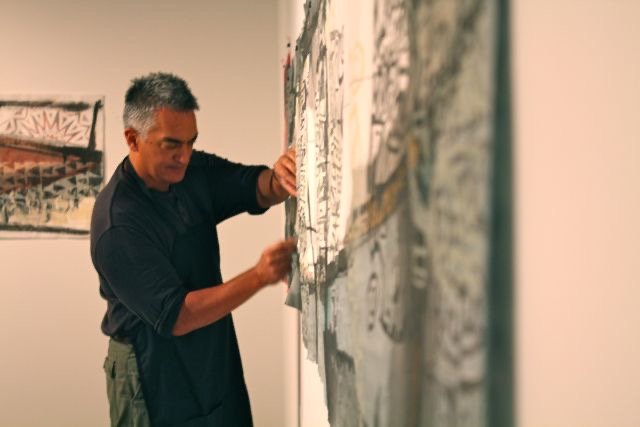MO‘IKEHA
2014, Mixed Media on paper
This work draws from the moʻolelo of Moʻikeha, the esteemed Polynesian chief and navigator whose journeys between Hawaiʻi and Kahiki embody themes of migration, return, and ancestral continuity. Created during an Indigenous artist residency at the Longhouse at Evergreen State College in Olympia, Washington, Moʻikeha reflects Herman Piʻikea Clark’s commitment to visual storytelling grounded in genealogy, place, and cultural resurgence.
The piece was developed through a layered process of relief printing, gestural drawing, and mixed media techniques. Symbolic motifs—derived from Clark’s vocabulary of Indigenous abstraction—are repeated and reframed to suggest navigational maps, celestial alignments, and ancestral architecture. At the heart of the composition, a sail-like form anchors the work, evoking the voyage of Moʻikeha and the directional knowledge passed across generations.
The Longhouse provided a culturally resonant space for the creation of this work—a setting that supported deep reflection on Indigenous connections across the Pacific. Moʻikeha is both an aesthetic meditation and a cultural offering, inviting viewers to consider how the stories of voyaging ancestors continue to guide us in the present.
THE PROCESS
This artwork was created in dialogue with the sacred Hawaiian ‘oli Nā ‘Aumākua, specifically the invocation: “E mālama ‘oukou iā mākou” — “Watch over us, care for us.” These words served as both anchor and atmosphere in the creation process, guiding each gesture with intention and reverence. Rather than illustrating the chant, this series offers a visual embodiment of its spirit. The panels were created through a process of layering, veiling, and uncovering—each step mirroring the rhythms of the chant itself. Using acrylic and mixed media, I explored the boundaries between form and formlessness, presence and invisibility—echoing the way our ‘aumākua move between worlds. The soft, pale hues suggest the liminal: dreams, clouds, winds, breath. The geometric forms—abstract yet genealogically charged—reflect pathways of connection between ancestors and descendants. Each panel stands as a visual prayer, a call and response across generations. In honoring the plea of “E mālama ‘oukou iā mākou,” this work becomes both an offering and a request: a way to remember, to be remembered, and to affirm that the care of our ancestors surrounds us still.







